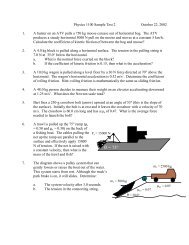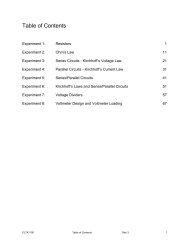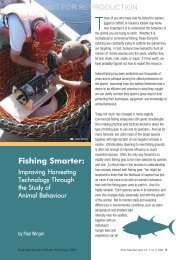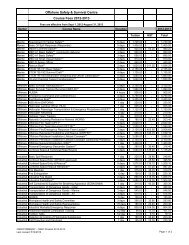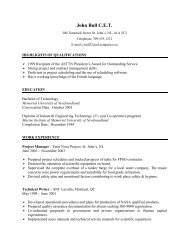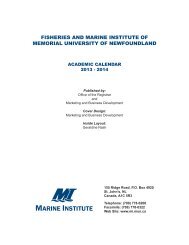Y:\How to solve 2 dimension relative velocity problems.wpd
Y:\How to solve 2 dimension relative velocity problems.wpd
Y:\How to solve 2 dimension relative velocity problems.wpd
You also want an ePaper? Increase the reach of your titles
YUMPU automatically turns print PDFs into web optimized ePapers that Google loves.
How <strong>to</strong> Solve 2 Dimension Relative Velocity Problems<br />
Any two <strong>dimension</strong> <strong>relative</strong> <strong>velocity</strong> problem is an application of vec<strong>to</strong>r addition. There are two<br />
scenarios you must learn <strong>to</strong> identify, when reading a question. Also, it is important <strong>to</strong> note that<br />
what happens in one direction is independent of what happens in the other and that only time of<br />
travel is common <strong>to</strong> both.<br />
1. Read the problem carefully! At this point you need <strong>to</strong> determine if we have a case 1 or<br />
case 2 problem. In case 1, the object of interest is compared <strong>to</strong> a moving surface or<br />
medium, for example a boat in a river or a balloon in the wind. In case 2, the object of<br />
interest is compared <strong>to</strong> another moving object. The both objects must be on a common<br />
surface or in a common medium and this surface or medium has a constant <strong>velocity</strong>,<br />
usually it is at rest, for example a shark chasing a fish.<br />
Read the following practice exercise and determine what case of <strong>relative</strong> <strong>velocity</strong> is<br />
described. Then make a statement about the why you think this is so.<br />
i. Practice 1: A large panel van has a <strong>velocity</strong> of 30 m/s at 20° S of E in still<br />
air. A gust of wind of 20 m/s due East <strong>relative</strong> <strong>to</strong> the Earth strikes the van.<br />
What is the resultant <strong>velocity</strong> of the van <strong>relative</strong> <strong>to</strong> the Earth, during the<br />
gust<br />
ANSWER:<br />
Case 1. The van is the object of interest and is affected by a moving medium, the<br />
wind. The speed of the wind (air) is <strong>relative</strong> <strong>to</strong> the Earth. The speed of the van is<br />
<strong>relative</strong> <strong>to</strong> the air.<br />
ii.<br />
Practice 2: U-531 fires a <strong>to</strong>rpedo at a freighter in the North Atlantic. The<br />
<strong>to</strong>rpedo travels at 27 knots NW. The freighter travels at 7 knots 30° S of<br />
E. What is the <strong>velocity</strong> of the <strong>to</strong>rpedo <strong>relative</strong> <strong>to</strong> the freighter<br />
ANSWER:<br />
Case 2. The object of interest is the <strong>to</strong>rpedo and is compared <strong>to</strong> a freighter,<br />
another moving object. Both the <strong>to</strong>rpedo’s and freighter’s <strong>velocity</strong> are <strong>relative</strong> <strong>to</strong><br />
the ocean (water). We assume the water is still.<br />
2. Now you need <strong>to</strong> determine what you are looking for. This means you must read the<br />
problem and determine the <strong>velocity</strong> you need <strong>to</strong> find and its reference frame.<br />
i. Practice 1: A large panel van has a <strong>velocity</strong> of 30 m/s at 20° S of E in still<br />
air. A gust of wind of 20 m/s due East <strong>relative</strong> <strong>to</strong> the Earth strikes the van.<br />
What is the resultant <strong>velocity</strong> of the van <strong>relative</strong> <strong>to</strong> the Earth, during the<br />
gust<br />
ANSWER:<br />
The <strong>velocity</strong> of the van <strong>to</strong> the earth. We write this using subscripts V vE . The first<br />
letter of the subscript identifies the object, ‘v’ means van. The second letter of<br />
the subscript identifies the frame of reference, ‘E’ means Earth. Literally
translated V vE means “the <strong>velocity</strong> of the van <strong>relative</strong> <strong>to</strong> the Earth.”<br />
ii.<br />
Practice 2: U-531 fires a <strong>to</strong>rpedo at a freighter in the North Atlantic. The<br />
<strong>to</strong>rpedo travels at 27 knots NW. The freighter travels at 7 knots 30° S of<br />
E. What is the <strong>velocity</strong> of the <strong>to</strong>rpedo <strong>relative</strong> <strong>to</strong> the freighter<br />
Answer: The <strong>velocity</strong> of the <strong>to</strong>rpedo <strong>to</strong> the freighter. We write this using subscripts V tf .<br />
The first letter of the subscript identifies the object, ‘t’ means <strong>to</strong>rpedo. The<br />
second letter of the subscript identifies the frame of reference, ‘f’ means freighter.<br />
Literally translated V tf means “the <strong>velocity</strong> of the <strong>to</strong>rpedo <strong>relative</strong> <strong>to</strong> the<br />
freighter.”<br />
3. Now you need determine the velocities of all important objects / surfaces. This means<br />
you must read the problem and identify all the listed velocities, again paying attention <strong>to</strong><br />
the subscripts.<br />
i. Practice 1: A large panel van has a <strong>velocity</strong> of 30 m/s at 20° S of E in still<br />
air. A gust of wind of 20 m/s due East <strong>relative</strong> <strong>to</strong> the Earth strikes the van.<br />
What is the resultant <strong>velocity</strong> of the van <strong>relative</strong> <strong>to</strong> the Earth, during the<br />
gust<br />
ANSWER:<br />
We are given the <strong>velocity</strong> of the van <strong>to</strong> the air. V va = 30 m/s at 20° S of E. Also,<br />
we are given the <strong>velocity</strong> of the air <strong>to</strong> the Earth. V aE = 20 m/s E. Note the<br />
subscript ‘a’ here means air.<br />
ii.<br />
Practice 2: U-531 fires a <strong>to</strong>rpedo at a freighter in the North Atlantic. The<br />
<strong>to</strong>rpedo travels at 27 knots NW. The freighter travels at 7 knots 30° S of<br />
E. What is the <strong>velocity</strong> of the <strong>to</strong>rpedo <strong>relative</strong> <strong>to</strong> the freighter<br />
Answer:<br />
We are given the <strong>velocity</strong> of the <strong>to</strong>rpedo <strong>to</strong> the water. V tw = 27 kts at NW. Also,<br />
we are given the <strong>velocity</strong> of the freighter <strong>to</strong> the water. V tw = 7 kts 30° S of E.<br />
Note the subscript ‘w’ here means water.<br />
4. Now you are ready <strong>to</strong> write the vec<strong>to</strong>r addition equation <strong>to</strong> <strong>solve</strong> your problem. Below is<br />
a template equation. The subscripts in the answer match the extreme subscripts in the<br />
added velocities. The inner subscripts, of the added velocities, ought <strong>to</strong> match each<br />
other.
i. Practice 1: A large panel van has a <strong>velocity</strong> of 30 m/s at 20° S of E in still<br />
air. A gust of wind of 20 m/s due East <strong>relative</strong> <strong>to</strong> the Earth strikes the van.<br />
What is the resultant <strong>velocity</strong> of the van <strong>relative</strong> <strong>to</strong> the Earth, during the<br />
gust<br />
It is worth pointing out now that we know V va = 30 m/s at 20° S of E, and<br />
V aE = 20 m/s E.<br />
ii.<br />
Practice 2: U-531 fires a <strong>to</strong>rpedo at a freighter in the North Atlantic. The<br />
<strong>to</strong>rpedo travels at 27 knots NW. The freighter travels at 7 knots 30° S of<br />
E. What is the <strong>velocity</strong> of the <strong>to</strong>rpedo <strong>relative</strong> <strong>to</strong> the freighter<br />
It is worth pointing out now that we know V tw = 27 kts NW, and V fw = 7<br />
kts at 30° S of E. However, we really need <strong>to</strong> know “the <strong>velocity</strong> of the<br />
water <strong>relative</strong> <strong>to</strong> the freighter”, V wf and not “the <strong>velocity</strong> of freighter <strong>to</strong> the<br />
water,” V fw !!!!<br />
Before proceeding <strong>to</strong> the next step, lets determine “the <strong>velocity</strong> of the<br />
water <strong>relative</strong> <strong>to</strong> the freighter”, V wf. The following is a unique feature of<br />
case 2 <strong>relative</strong> <strong>velocity</strong> <strong>problems</strong>. That is V wf = - V fw . This means the size<br />
of both velocities are the same, but the directions of each are perfectly<br />
opposing. Therefore, V wf = 7 kts at 30° N of W!
5. Last step before the math, draw a labelled tip <strong>to</strong> tail diagram based on the vec<strong>to</strong>r equation<br />
you wrote.<br />
i. Practice 1: A large panel van has a <strong>velocity</strong> of 30 m/s at 20° S of E in still<br />
air. A gust of wind of 20 m/s due East <strong>relative</strong> <strong>to</strong> the Earth strikes the van.<br />
What is the resultant <strong>velocity</strong> of the van <strong>relative</strong> <strong>to</strong> the Earth, during the<br />
gust<br />
ii.<br />
Practice 2: U-531 fires a <strong>to</strong>rpedo at a freighter in the North Atlantic. The<br />
<strong>to</strong>rpedo travels at 27 knots NW. The freighter travels at 7 knots 30° S of<br />
E. What is the <strong>velocity</strong> of the <strong>to</strong>rpedo <strong>relative</strong> <strong>to</strong> the freighter
6. The math, with vec<strong>to</strong>r addition there are many options and these are classified by<br />
graphical and analytical means. In this tu<strong>to</strong>rial we will concentrate on the most efficient<br />
analytical means. When adding two vec<strong>to</strong>rs the Law of Sines and Cosines is probably<br />
best. However, the component method is easier <strong>to</strong> visualize. I will show both solutions<br />
for each problem.<br />
i. Practice 1: A large panel van has a <strong>velocity</strong> of<br />
30 m/s at 20° S of E in still air. A gust of<br />
wind of 20 m/s due East <strong>relative</strong> <strong>to</strong> the Earth<br />
strikes the van. What is the resultant <strong>velocity</strong><br />
of the van <strong>relative</strong> <strong>to</strong> the Earth, during the<br />
gust<br />
(1) Component method.<br />
Vec<strong>to</strong>r (v) and angle (2)<br />
X-comp<br />
v x = vcos2<br />
Y-comp<br />
v y = vsin2<br />
V va = 30 m/s, 20° V vax = 28.19 V vay = -10.26<br />
V vE = 20 m/s, 0° V vax = 20 V vEy = 0<br />
Resultant V vEx = 48.19 V vEy = -10.26<br />
Note using your diagram, YOU determine is a component is positive or negative.<br />
2 2 2 2<br />
vE vEx vEy<br />
v = v + v = 48.19 + ( − 10.26) = 49.3<br />
v −10.26<br />
θ = = = °<br />
v<br />
48.19<br />
−1 vEy −1<br />
tan ( ) tan ( ) 12.0 S of E<br />
vEx<br />
2 2<br />
vE<br />
=<br />
va<br />
+<br />
aE<br />
−<br />
va aE<br />
2 2<br />
30 20 2(30)(20)cos160 49.2<br />
m s<br />
m s<br />
v v v 2( v )( v )cosθ<br />
v<br />
vE<br />
= + − =<br />
−1 vaE<br />
sinθ<br />
−1<br />
20sin160<br />
β = sin ( ) = sin ( ) = 8.0°<br />
v<br />
49.2<br />
vE<br />
α = 20°− β = 12.0°<br />
(2) Law of sines and cosines
ii.<br />
Practice 2: U-531 fires a <strong>to</strong>rpedo at a<br />
freighter in the North Atlantic. The<br />
<strong>to</strong>rpedo travels at 27 knots NW. The<br />
freighter travels at 7 knots 30° S of E.<br />
What is the <strong>velocity</strong> of the <strong>to</strong>rpedo<br />
<strong>relative</strong> <strong>to</strong> the freighter<br />
(1) Component method.<br />
Vec<strong>to</strong>r (v) and angle (2)<br />
X-comp<br />
v x = vcos2<br />
Y-comp<br />
v y = vsin2<br />
V tw = 27 kts, 45° V twx = -19.1 V twy = 19.1<br />
V wf = 7 kts, 30° V wfx = -6.1 V wfy = 3.5<br />
Resultant V tfx = -25.2 V tfy = 22.6<br />
Note using your diagram, YOU determine is a component is positive or negative.<br />
v = v + v = ( − 25.2) + (22.6) = 33.8 kts<br />
2 2 2 2<br />
tf tfx tfy<br />
v 22.6<br />
θ = = = °<br />
v −25.2<br />
−1 tfy −1<br />
tan ( ) tan ( ) 41.8 N of W<br />
tfx<br />
(2) Law of sines and cosines<br />
v = v + v −2v v cosθ<br />
2 2<br />
tf tw wf tw wf<br />
v<br />
v<br />
tf<br />
tf<br />
= + − °<br />
2 2<br />
27 7 2(27)(7)cos165<br />
= 33.8kts<br />
β =<br />
v<br />
sinθ<br />
−1<br />
wf<br />
sin ( )<br />
v<br />
−1<br />
7sin165°<br />
β = sin ( ) = 3.1°<br />
33.8<br />
tf<br />
α = 45°− β = 41.9°<br />
N of W






